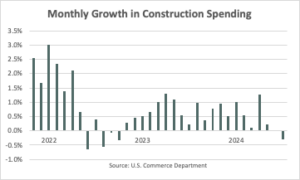by Arsene Aka, Senior Economist at Dodge Construction Network
According to the U.S. Commerce Department (Census Bureau), spending on construction projects fell 0.3% in July to a seasonally adjusted annual rate of $2.2 trillion, after being unchanged in June. Economists had expected construction spending to dip 0.1% in July. On a yearly basis, the total value of construction put in place increased 6.7% year-over-year in July. The monthly decline in construction spending can be attributed to declines in spending on both residential and nonresidential construction projects.
The residential sector is currently constrained by high mortgage rates and worsening builder confidence. The National Association of Home Builders’ Housing Market Index has been below its key threshold of 50 since May and on a downward trend since April, indicating the outlook for building conditions is pessimistic for the next six months. It is thus not surprising that spending on residential construction decreased 0.4% in July to an annual rate of $953 billion, with outlays on new single-family construction projects dropping a robust 1.9%. In addition, outlays on new multi-family housing were flat during the month.
Meanwhile, spending on nonresidential construction edged down 0.2% in July to an annual rate of $1.2 trillion, as 11 of the 16 nonresidential construction sectors posted monthly declines. Outlays on religious and healthcare projects posted robust declines during the month. On the other hand, spending on office, transportation, sewer, water, and manufacturing construction projects rose in July.
In the first seven months of 2024, construction spending rose 8.8% to an unadjusted level of $1.2 trillion. Residential construction outlays grew 9.4% during that period to $549 billion. Meanwhile, spending on nonresidential construction projects rose 8.3% to $688 billion. Dodge Construction Network expects the Federal Reserve will begin easing monetary policy this month, cutting rates at the conclusion of its forthcoming September meeting. The Fed is expected to lower rates further in December. Lower interest rates will benefit the residential sector and interest-sensitive construction sectors. In short, Dodge expects robust growth in construction spending over the next two years.

